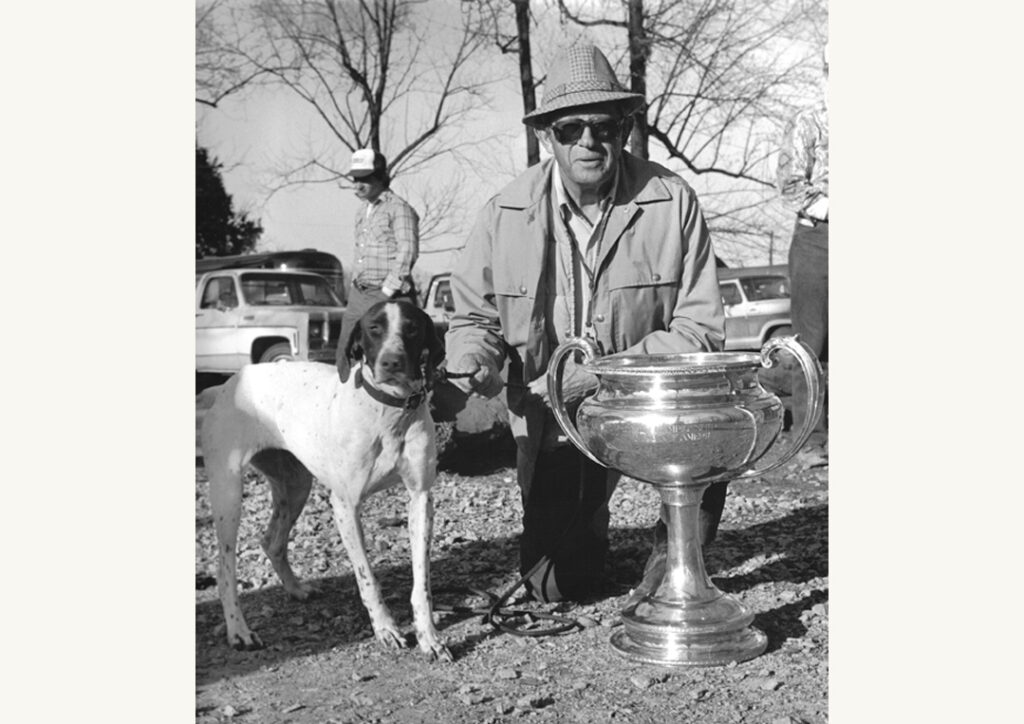Parke C. Brinkley — Ken L Ration Professional Biskit Handler of the Year Award (1991)
I am very pleased and proud and honored to have been invited to be your banquet speaker on this very special occasion.
I want to congratulate the Quaker Oats Company for all that they have done over the years in a wide area of production (an outstanding dog food is just one of their fine products). My grandfather was a rancher in Colorado during the period of 1860-1890 and my mother said that he bought oatmeal by the barrel because the cowboys wanted it every morning for breakfast because they said that it stayed with them all day in the saddle. My mother brought the idea to Virginia and I became accustomed to seeing the Old Quaker’s beaming face early in life and still see it whenever I open the cabinet door. Some of the credit for the fine quality of the company’s wide range of products goes to my good friend Dr. Fred Dobbins who was director of Quality Control for some years before his retirement. Dr. Dobbins and I were not only classmates but close personal friends throughout our four years in college and it has continued.
Quaker Oats is especially to be congratulated for publicly recognizing the great contribution that professional handlers have made to field trials over the years. Their’s is a tough profession and a hard life but one filled with great rewards. One of their greatest rewards is seeing a good young dog grow and develop. One of their greatest disappointments is in seeing a good dog have a poor owner.
I also want to congratulate the Association of Virginia Field Trial Clubs for the contribution that it has made to bird dogs and field trials in Virginia since its organization in 1958. It has never been stronger nor has it had more influence than it has today under the leadership of Gene Hogg and Rogers Huff.
And, of course, I certainly want to congratulate Colvin Davis and George Tracy, two fine gentlemen both of whom are great handlers. Both of them are fortunate to have a string of fine dogs and a group of outstanding owners.
To talk about field trials in Virginia one has to start with Edward Dexter. Mr. Dexter’s home was in Buzzards Bay, Massachusetts, but his heart resided in Virginia at his Charlottesville Field Trial Kennel where Captain McMurdo was the manager and trainer and C. E. Buckle, a young Britisher, was his assistant.
The setter, of course, had dominated field trial competition since the first trial was held in 1874 near Memphis, Tennessee. But Ned Dexter was a pointer man and he worked at developing pointers that could compete with setters with no holes barred. Now if any of you pointer fanciers will trace the pedigree of almost any good field trial winner of today, you will find that it goes right back to the Charlottesville Kennels of Edward Dexter and to such English imports as King of Kent, Hops, Mainspring, and Pontiac. Bred and developed there from these imported dogs were such greats as Rip Rap, Jingo, and Maid of Kent.
The first organized field trial club in Virginia was the Page Valley Club which held its first trial in 1912 near Lurray. It operated for a good many years before it disbanded. And it was there that I did some of my first winning.
The Virginia Amateur Field Trial Association was organized in the summer of 1920 and held its first trial that fall just north of Richmond. This Club was started by a group of outstanding businessmen of Richmond headed by Ernest Mead, a nephew of Captain McMurdo of Charlottesville Kennel fame. It is interesting to note that the only man in this group that had ever seen a field trial was Charley Cooke, another of the early field trial men of Virginia, who owned such dogs as Champion Prince Rodney, Sport’s Boy and others. This first trial got lots of publicity in the Richmond newspapers and the Club soon had five hundred paid members. It was also the first club in Virginia to run on continuous courses. There had always been a very close working relationship between that Club and the Virginia Game Commission and it was only natural that in 1928 the Game Commission allowed the Club to run on the Camp Lee Game Refuge, a World War I training base that had been idle during the years since the war. Its sedge fields and lightly wooded areas that were heavily seeded to Lespediza was a haven for “Bob White.” They were such good grounds that the National Amateur Quail Championship was run there in 1931-1933 and 1937. The war clouds of World War II caused Camp Lee to become activated again and the fall of 1940 saw the last trial there. As a matter of fact, I won that all-age stake with Tip Top Sport, owned by Lee Cole and in the string of Herman Smith. I owned both the sire and dam of this dog which, of course, made it more thrilling for me.
The Rappahannock Trial ran for many years and at various locations, but for several years beginning about 1941 its spring trial was of major circuit quality. It was scheduled as the first of the four major circuit spring trials — Rappahannock, Oriole, Jockey Hollow, and English Setter. It was run on the Northern Neck of Virginia which is a vast area of large farms lying between the Potomac and Rappahannock Rivers. The courses were all run across privately owned farms. There weren’t many birds but we had some great ground races. It was always well attended and we usually had at least three dogs with acceptable bird work.
Several clubs were formed in Virginia over the next few years and in 1958 the Association of Virginia Field Trial Clubs was organized with A. L. “Pon” Lippitt as president and Verle Farrow as secretary and treasurer. The purpose of the Association was “to promote and coordinate field trial activities in Virginia and to establish an Open Shooting Dog Classic which could later become a championship.” Verle Farrow, of course, was the work horse and mainstay. In 1960 they asked me to be president with the primary object being to get a state Open Shooting Dog Championship started. They said that there were lots of shooting dog stakes being run but without any set standards to guide them. I knew the need and agreed to serve but asked them if they had rather see a state or national championship. They immediately said national. The first thing that Verle and I did was to go to my very close friend and associate, Guy Lewis, who owned Hawfield, a 2,760 acre farm in Orange County. This was a great place to run field trials. We asked him if he would be a founder of the trial, if we could get it started and would he allow it to be run over the courses at Hawfield? Although he was strictly an all-age man he recognized the growing popularity of shooting dog stakes as well as the need for establishing such a trial, so he agreed to support the effort.
Verle and I discussed the whole thing in detail and decided what we would need in order to get the club started and the championship approved. We knew that we needed know-how, enthusiasm, dedication, money, and legal assistance. We talked to Steve Richardson and Harold Crane and they agreed to put up five thousand dollars each. We then talked to Frank Baugh, an attorney who was interested in trials, and he agreed to do the legal work. The next step was to get the trial approved as a championship for the first running rather than going through the usual process of demonstrating the quality of the stake by running it for two or three years. So, during a business trip to Chicago, I arranged a conference with Bill Brown. He expressed a strong desire to see a set of standards established and a trial organized to demonstrate them. He expressed a willingness to recognize it as a championship the first year because of the soundness of the proposal, the experience of the Classic, and the integrity of the men who had agreed to support it. He later assisted me in writing the Standards. These Standards, of course, are still being used today and have largely guided the running of the Shooting Dog Stakes throughout the United States, Canada, Mexico, and Japan.
The trial was run for ten years at Hawfield, then moved to Di-Lane Plantation at Waynesboro, Georgia, and later to Sedgefields Plantation at Union Springs, Alabama, where it continues to run under the direction of Bill Hembree and an active board of directors.
Let there be no doubt in anybody’s mind but that Verle Farrow, who rode every single brace for the first twenty years, and who has served this Club as secretary, treasurer, business manager, judge, and reporter, was the mainstay of the whole endeavor.
The Association of Virginia Field Trial Clubs later established the Eastern Open Shooting Dog Championship which had been extremely successful and continues to run at Elm Hill (now the Richard H. Cross Wildlife Management Area).
A number of Virginians have made and are making great contributions to the field trial game.
Men like:
Edward Dexter, a man of great foresight, was not only a great breeder but was the spark plug in taking the basic idea that Billy Titus had and developing it into the National Championship. He served as its first president until his death in 1901. According to the book by Bill Brown and Nash Buckingham entitled National Field Trial Champions (from which much of this information was gathered) the Association was formed in 1895 and ran its first trial in 1896 near West Point, Mississippi. In 1899, at the age of seventy-three, Mr. Dexter sold his kennel to a young man, Hobart Ames, who moved the kennel and its assistant manager, C. E. Buckle, to his plantation at Grand Junction, Tennessee. Buckle was made superintendent of the Ames Plantation where he served for many years; seventeen of which he judged the National Championship.
Four men: Ernest Mead, Fritz Sitterding, Virgil Hawse, and Guy Lewis have served as president of the Amateur Field Trial Clubs of America (AFTCA). Of these Ernest Mead was the father of the Regional Championships and Guy Lewis was the one who, working with L. B. Maytag, brought the National Shooting Dog Championship into the fold of the Amateur Field Trial Clubs of America, and got it recognized as an Amateur Free-For-All Championship.
Willie Craig did for dog training what Henry Ford did for automobile manufacturing — put it on an assembly line basis. With five thousand dollars that he had saved while working for the Norfolk and Western Railroad in Roanoke, he went to Louisa County and began training dogs for the public in 1926. In a few years he had four trainers working for him and over two hundred dogs in training. In fifteen years he sold out to his son-in-law, Elgin Nininger and had upwards of a quarter million dollars of real estate in Roanoke and two thousand acres of farm land in Louisa County that was all paid for. This was during the Great Depression years. And most importantly, he had hundreds of satisfied owners.
Claud Stickley, a small farmer in the Shenandoah Valley, started making history in 1925 when he won the Virginia Amateur Derby with a small, white setter (Florendale Lou’s Beau) which he bred. Five years later, after the little dog had garnered a world of admirers throughout Virginia and the adjoining states, Claud gave him to his dear friend Virgil Hawse.
Virgil Hawse was a successful ford dealer, an outstanding amateur handler, and above all a great promoter. He outlined a long-time breeding program based on Beau which included inbreeding and intensive line breeding. He described this plan in detail in a feature article that was published in a summer issue of the American Field. He was very successful in his breeding program and bred lots of very attractive dogs including Beau Essig, Beau Essig’s Don, Equity, and many others. One of Virgil’s basic rules was that he would not breed a bitch until after she had won in all-age stakes. Almost all of these dogs were bold, stylish, good looking bird finders. Many of them made good amateur all-age dogs and lots of them would have made what we speak of today as open shooting dogs. Beau Essig Don, under the whistle of Herman Smith, was a successful all-age contender. It is regretful that someone didn’t carry on this breeding program.
Herman Smith (The Little Fox) was born and reared near Salem, Virginia, and trained there for some years. He was quite successful of the Virginia-Carolina circuit but later moved to Alabama. He developed and handled many outstanding dogs including two National Champions, Satilla Virginia Lady and Wayriel Allegheny Sport. Herman changed the field trial handling style. Until then handlers rode just in front of the judges. He started cantering to the top of the next hill and sitting there until the judges rode up to him. From this he gradually started staying farther and father out front. Judges allowed him to do this and other handlers started doing it until now all the handlers do the same thing. Until the early 1940s handlers always turned their dog loose themselves at the breakaway and following points, watering, etc. George Rogers and I often scouted for each other and we decided that we would let the scout tum them loose. This saved some mistakes and before long most people were doing the same thing.
Guy Lewis’ name keeps popping up, and rightly so, because he wrote a great chapter in Virginia field trial history. He bought a run-down farm of 2,760 acres in Orange County, Hawfield, and at considerable expense and with great personal effort made it into great field trial grounds. The National Amateur Quail Championship and the National Amateur Shooting Dog Championship as well as several Regionals and Classics were run there. It was the home of the Virginia Amateur during its hey day and the National Open Shooting Dog Championship was born and ran its first ten renewals there.
Clarence Edwards was an outstanding man with a young dog and was schooled under the guiding hand of Paul Walker. In the early forties a young man named Bill Jones had been trying unsuccessfully to get a winning dog and was complaining to me about it one day. I suggested that he try pointers and offered to let him have an Air Sam bitch that I had if he would breed her to a young dog named Fast Delivery. He took me up on it and when the puppies came he gave one of them to his friend Clarence Edwards. I met Clarence the next spring at a trial where he won the puppy stake with Excello, the pup Bill Jones had given him, and placed another pup called Free Press. He took me aside, told me that he loved to work young dogs but didn’t have much money and that a man named Dr. Longsdorf in New Jersey had called him and offered him a thousand dollars for Excello but that he had turned him down. He wanted my advice. I told him to call Dr. Longsdorf back and tell him he would accept the offer. I saw him the next week and when I asked him what happened he said Dr. Longsdorf had given him twelve hundred for Excello and eight hundred for Free Press. They were put with Ed Mack Farrior and he had a good bit of success with them. Soon after this Clarence came out with a young dog named The Haberdasher with whom he was quite successful. He found a home for “Ole John” with another rich doctor named McCall. Soon thereafter he went to the Pinehurst Trials and won the Derby with Earl of Chatham and sold him that night to Bill Jones for a long price. Bill promptly renamed him Home Again Mike. (You all know the success both Bill and Paul Walker had with him.) Next he came to the Virginia Amateur with a puppy that he called Paladin’s Royal Flush. The word got out that he had another good one and John Rex Gates gave him twenty-five hundred for him. There again, you know the success John Rex had with him both as a winner and producer. It was a real loss to Virginia when Clarence died so young.
Verle Farrow’s name, like that of Guy Lewis keeps popping up because he had had such a great impact on field trials in Virginia over a long period of years. One of his contributions was through another little white setter from the Florendale Lou’s Beau line. This one named Long Gone Sam. He was a great little dog and a good sire. He was an all-age dog but Verle, by working him down, also won some shooting dog stakes. Sam, through his son Long Gone Stokley, is having an impact on the cover dogs of New England. Verle was also the first secretary-treasurer of both The Pheasant Shooting Dog Futurity and The Quail Shooting Dog Futurity. He served in this capacity for a period of eighteen years. During this time he developed a card file of futurity breeders and others containing some sixteen hundred names.
Dr. Keith Severin, a successful breeder, owner and handler has been active promoting dogs in general and bird dogs in particular not only in Virginia but throughout the world. For the past ten years he has been carrying on the work of The Shooting Dog Futurities taking over the job of secretary-treasurer, a task into which his friend Verle Farrow had put so much time and effort.
Eight Virginia dogs have been elected to The Field Trial Hall of Fame: Jingo, Rip Rap, The Haberdasher, Home Again Mike, Rambling Rebel Dan, A Rambling Rebel, Wayriel Allegheny Sport, and Beau Essig.
Six Virginia men, if you will let me claim Edward Dexter and Herman Smith, have been elected to The Hall of Fame: Edward Dexter, Virgil Hawse, Guy Lewis, Verle Farrow, Herman Smith and last as well as least, myself.
Virginia has made some great contributions to field trials in the past and is still making them through such organizations as The Association of Virginia Field Trail Clubs as well as through a number of fine young men who breed and run their own dogs and do it very successfully. Yes, field trials in Virginia are in good hands.
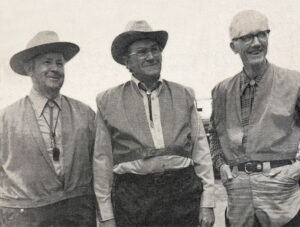
1975 National Open Shooting Dog Championship judges: Earnest Newman, George L. Harden Jr., and Verle Farrow. The championship was run at Sedgefields Plantation near Union Springs, AL.

Hall of Fame pointers Jingo and Rip Rap
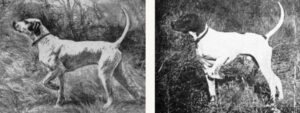
Hall of Fame pointers The Haberdasher and Home Again Mike
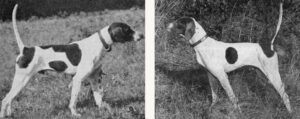
Hall of Fame pointers Rambling Rebel Dan and A Rambling Rebel
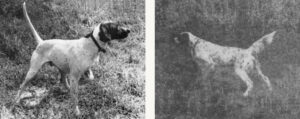
Hall of Fame pointer Wayriel Allegheny Sport and English setter Beau Essig
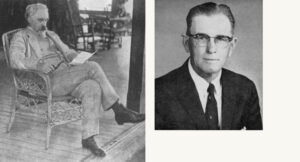
Hall of Famers Edward Dexter and Herman Smith
* * * * *
Parke C. Brinkley was a member of the Virginia Amateur Field Trial Association from 1937 until his death. He was a founder of the National Open Shooting Dog Championship and wrote the standard for it though he was always an “All-Age Guy.” He was a director of the National Championship which he judged on five occasions. Parke won the 1966 National Amateur Shooting Dog Championship with My Sallee and the 1981 National Amateur Quail Championship with Arcanum’s Aspasia (featured photo). He was inducted into the Field Trial Hall of Fame in 1990. Parke Culver Brinkley died at the age of 93 on November 26, 2008 in South Hill, Virginia.
